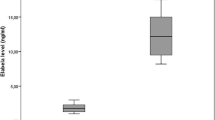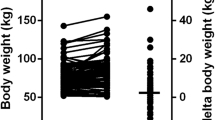Abstract
Acromegaly is associated with increased morbidity and mortality from cardiovascular disease. Inflammatory markers, such as C-reactive protein and leucocyte count, haemostatic markers, such as fibrinogen and factor VIII and cardiac hypertrophy marker, B-type natriuretic peptide, have emerged as important cardiovascular risk markers in the general population. The objective of this study was to assess the serum levels of conventional, inflammatory, haemostatic markers and NT-pro BNP in mostly non-diabetic normotensive patients with acromegaly, as well as the effect of 6 months of octreotide LAR therapy on these markers. We studied 12 patients with active acromegaly, 12 patients in whom remission of acromegaly had been achieved by surgery and 12 healthy control subjects matched for age, gender and body mass index. At baseline fasting blood was obtained for measurements of GH, IGF-1, glucose, insulin, lipids, lipoprotein (a), C-reactive protein, leucocyte count, fibrinogen, factor VIII and NT-pro BNP. After baseline evaluation, patients with active acromegaly were treated with octreotide LAR for 24 weeks. At 24 weeks, measurements were repeated as on baseline. Insulin resistance index and fibrinogen levels were higher in patients with active acromegaly than patients and subjects in control groups. CRP, leucocyte count, factor VIII and NT-pro BNP were similar in the three groups. Octreotide LAR reduced GH, IGF-1 and insulin resistance index but did not alter levels of CRP and NT-pro BNP.
Similar content being viewed by others
References
Alexander L, Appleton D, Hall R, Ross WM, Wilkinson R (1980) Epidemiology of acromegaly in the Newcastle region. Clin Endocrinol (Oxf) 12(1):71–79
Mestron A, Webb SM, Astorga R, Benito P, Catala M, Gaztambide S, Gomez JM, Halperin I, Lucas-Morante T, Moreno B, Obiols G, de Pablos P, Paramo C, Pico A, Torres E, Varela C, Vazquez JA, Zamora J, Albareda M, Gilabert M (2004) Epidemiology, clinical characteristics, outcome, morbidity and mortality in acromegaly based on the Spanish acromegaly registry (Registro Espanol de Acromegalia, REA). Eur J Endocrinol 151(4):439–446
Lombardi G, Galdiero M, Auriemma RS, Pivonello R, Colao A (2006) Acromegaly and the cardiovascular system. Neuroendocrinology 83(3–4):211–217
Colao A, Pivonello R, Marzullo P, Auriemma RS, De Martino MC, Ferone D, Lombardi G (2005) Severe systemic complications of acromegaly. J Endocrinol Invest 28(5 Suppl):65–77
Vitale G, Pivonello R, Lombardi G, Colao A (2004) Cardiovascular complications in acromegaly. Minerva Endocrinol 29(3):77–88
Vitale G, Pivonello R, Lombardi G, Colao A (2004) Cardiac abnormalities in acromegaly. Pathophysiology and implications for management. Treat Endocrinol 3(5):309–318
Colao A, Ferone D, Marzullo P, Lombardi G (2004) Systemic complications of acromegaly: epidemiology, pathogenesis, and management. Endocr Rev 25(1):102–152
Colao A, Vitale G, Pivonello R, Ciccarelli A, Di Somma C, Lombardi G (2004) The heart: an end-organ of GH action. Eur J Endocrinol 151(Suppl 1):S93–S101
Colao A, Spinelli L, Marzullo P, Pivonello R, Petretta M, Di Somma C, Vitale G, Bonaduce D, Lombardi G (2003) High prevalence of cardiac valve disease in acromegaly: an observational, analytical, case-control study. J Clin Endocrinol Metab 88(7):3196–3201
Colao A (2001) Are patients with acromegaly at high risk for dysrhythmias? Clin Endocrinol (Oxf) 55(3):305–306
Vitale G, Pivonello R, Auriemma RS, Guerra E, Milone F, Savastano S, Lombardi G, Colao A (2005) Hypertension in acromegaly and in the normal population: prevalence and determinants. Clin Endocrinol (Oxf) 63(4):470–476
Danesh J, Wheeler JG, Hirschfield GM et al (2004) C-reactive protein and other circulating markers of inflammation in the prediction of coronary heart disease. N Engl J Med 350:1387–1397
Wang TJ, Larson MG, Levy D et al (2004) Plasma natriuretic peptide levels and the risk of cardiovascular events and death. N Engl J Med 350:655–663
Danesh J, Lewington S, Thompson SG et al (2005) Plasma fibrinogen level and the risk of major cardiovascular diseases and nonvascular mortality: an individual participant meta-analysis. JAMA 294:1799–1809 [Erratum, JAMA 2005;294: 2848.]
Cushman M, Lemaitre RN, Kuller LH et al (1999) Fibrinolytic activation markers predict myocardial infarction in the elderly: the cardiovascular health study. Arterioscler Thromb Vasc Biol 19:493–498
Mangoni AA, Jackson SH (2002) Homocysteine and cardiovascular disease: current evidence and future prospects. Am J Med 112:556–565
Hunt PJ, Richards AM, Nicholls MG, Yandle TG, Doughty RN, Espiner EA (1997) Immunoreactive amino-terminal pro-brain natriuretic peptide (NT-PROBNP): a new marker of cardiac impairment. Clin Endocrinol 47(3):287–296
Sesmilo G, Fairfield WP, Katznelson L, Pulaski K, Freda PU, Bonert V, Dimaraki E, Stavrou S, Vance ML, Hayden D, Klibanski A (2002) Cardiovascular risk factors in acromegaly before and after normalization of serum IGF-I levels with the GH antagonist pegvisomant. J Clin Endocrinol Metab 87(4):1692–1699
Andreassen M, Faber J, Vestergaard H, Kristorp C, Kristensen LO (2007) N-terminal pro-B-type natriuretic peptide in patients with growth hormone disturbances. Clin Endocrinol 66:619–625 E-print
Matthews DR, Hosker JP, Rudenski AS, Naylor BA, Treacher DF, Turner RC (1985) Homeostasis model assessment: insulin resistance and beta-cell function from fasting plasma glucose and insulin concentrations in man. Diabetologia 28(7):412–419
Landin-Wilhelmsen K, Tengborn L, Wilhelmsen L, Bengtsson BA (1997) Elevated fibrinogen levels decrease following treatment of acromegaly. Clin Endocrinol (Oxf) 46(1):69–74
Colao A, Marzullo P, Lombardi G (2002) Effect of six-month treatment with lanreotide on cardiovascular risk factors and arterial intima-media thickness in patients with acromegaly. Eur J Endocrinol 146:303–309
Colao A, Spinelli L, Cuocolo A, Spiezia S, Pivonello R, di Somma C, Bonaduce D, Salvatore M, Lombardi G (2002) Cardiovascular consequences of early-onset growth hormone excess. J Clin Endocrinol Metab 87(7):3097–3104
Maison P, Demolis P, Young J, Schaison G, Giudicelli JF, Chanson P (2000) Vascular reactivity in acromegalic patients: preliminary evidence for regional endothelial dysfunction and increased sympathetic vasoconstriction. Clin Endocrinol (Oxf) 53(4):445–451
Ronchi CL, Corbetta S, Cappiello V, Morpurgo PS, Giavoli C, Beck-Peccoz P, Arosio M, Spada A (2004) Circulating adiponectin levels and cardiovascular risk factors in acromegalic patients. Eur J Endocrinol 150(5):663–669
Wang TJ, Gona P, Larson MG, Tofler GH, Levy D, Newton-Cheh C, Jaques PF, Rifai N, Selhub J, Robins SJ, Benjamin EJ, D’Agonistino RB, Vasan RS (2006) Multiple biomarkers for the prediction of first major cardiovascular events and death. New Engl J Med 355(25):2631–2639
Colao A, Spiezia S, Cerbone G, Pivonello R, Marzullo P, Ferone D, Di Somma C, Assanti AP, Lombardi G (2001) Increased arterial intima-media thickness by B-M mode echodoppler ultrasonography in acromegaly. Clin Endocrinol (Oxf) 54(4):515–524
Mattace-Raso F, van Popele NM, Schalekamp MA, van der Cammen TJ (2002) Intima-media thickness of the common carotid arteries is related to coronary atherosclerosis and left ventricular hypertrophy in older adults. Angiology 53(5):569–574
Lacroix P, Aboyans V, Espaliat E, Cornu E, Virot P, Laskar M (2003) Carotid intima-media thickness as predictor of secondary events after coronary angioplasty. Int Angiol 22(3):279–283
Takiuchi S, Rakugi H, Fujii H, Kamide K, Horio T, Nakatani S, Kawano Y, Higaki J, Ogihara T (2003) Carotid intima-media thickness is correlated with impairment of coronary flow reserve in hypertensive patients without coronary artery disease. Hypertens Res 26(12):945–951
Colao A, Baldelli R, Marzullo P, Ferretti E, Ferone D, Gargiulo P, Petretta M, Tamburrano G, Lombardi G, Liuzzi A (2000) Systemic hypertension and impaired glucose tolerance are independently correlated to the severity of the acromegalic cardiomyopathy. J Clin Endocrinol Metab 85(1):193–199
Acknowledgements
This work was supported by an unrestricted research grant from Novartis Canada. We would like to thank Mr. R. Boileau, statistician at the CHUM, for performing the statistical analyses.
Author information
Authors and Affiliations
Corresponding author
Rights and permissions
About this article
Cite this article
Potter, B.J., Beauregard, C. & Serri, O. Serum markers of cardiovascular risk in patients with acromegaly before and after six months of treatment with octreotide LAR. Pituitary 11, 49–53 (2008). https://doi.org/10.1007/s11102-007-0067-1
Published:
Issue Date:
DOI: https://doi.org/10.1007/s11102-007-0067-1




